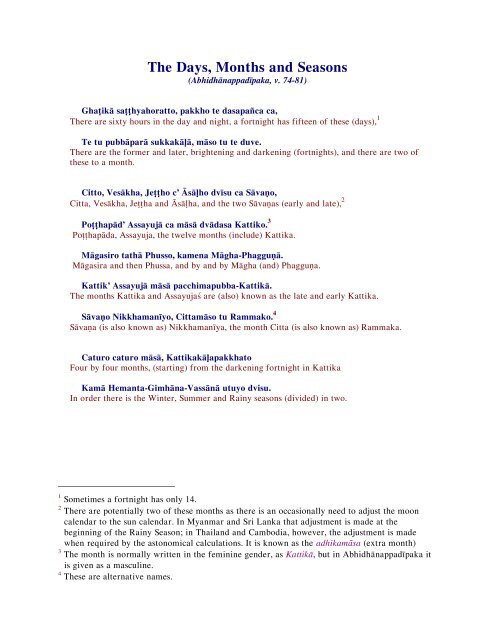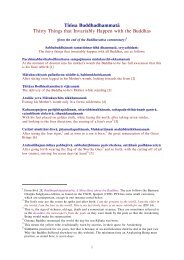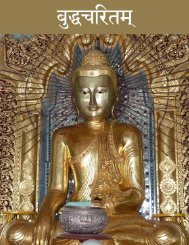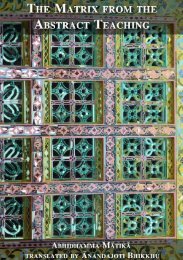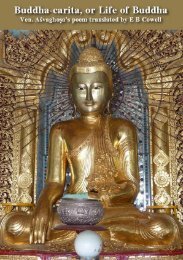The Days, Months and Seasons in Pali - Ancient Buddhist Texts
The Days, Months and Seasons in Pali - Ancient Buddhist Texts
The Days, Months and Seasons in Pali - Ancient Buddhist Texts
- No tags were found...
You also want an ePaper? Increase the reach of your titles
YUMPU automatically turns print PDFs into web optimized ePapers that Google loves.
Synopsis of the <strong>Months</strong> <strong>and</strong> <strong>Seasons</strong>Māsa = <strong>Months</strong> Cha Utu = Six <strong>Seasons</strong> Ti Utu = Three <strong>Seasons</strong>Citta = Mar-Apraka RammakaVasanta = Spr<strong>in</strong>gVesākha = Apr-MayGimhāna = SummerJeṭṭha = May-JunĀsāḷha = Jun-JulGimha = Hotaka Uṇha, NidāghaSāvaṇa = Jul-Augaka NikkhamanīyaPoṭṭhapāda = Aug-Sepaka BhaddapadāAssayuja = Sep-Octaka PubbakattikaKattika = Oct-Novaka PacchimakattikaVassāna = Ra<strong>in</strong>yaka Vassa PāvusaSarada = AutumnVassāna = Ra<strong>in</strong>yMāgasira = Nov-DecPhussa = Dec-JanMāgha = Feb-MarHemanta = SnowySisira = CoolHemanta = SnowyPhagguṇa = Feb-Mar
In Sanskrit the names are: Caitra, Vaiśākha, Jyaiṣṭha, Āṣāḍha, Śrāvaṇa, Bhādrapada, Āśv<strong>in</strong>a,Kārttika, Mārgaśīrṣa, Pauṣa, Māgha, Phālguna.In the <strong>Buddhist</strong> system the month itself normally consists of either 30 days (normally 18 times ayear) or 29 days (normally 6 times a year), <strong>and</strong> starts the day after full moon (puṇṇimantamāna),runn<strong>in</strong>g up till the follow<strong>in</strong>g full moon. <strong>The</strong> season also beg<strong>in</strong>s the day after the Full Moon.<strong>The</strong> <strong>Buddhist</strong> calendar calculations are based on the Lunisolar year. Important dates (like theAwaken<strong>in</strong>g) be<strong>in</strong>g commemorated on the Moon cycle, <strong>and</strong> the Moon cycle itself be<strong>in</strong>g adjusted tofit <strong>in</strong> with the Solar cycle.This results <strong>in</strong> an additional month be<strong>in</strong>g added <strong>in</strong> to the calendar roughly every 2 or 3 years (itnormally needs 7 extra months every 19 years). Intercalcery days (adhikavāra) are also added <strong>in</strong> as<strong>and</strong> when required, there be<strong>in</strong>g 11 extra days every 57 years.<strong>The</strong> <strong>Buddhist</strong> era (BE, which beg<strong>in</strong>s at year 0 <strong>in</strong> Sri Lanka, <strong>and</strong> year 1 <strong>in</strong> Thail<strong>and</strong>) starts at the daythe Buddha atta<strong>in</strong>ed Par<strong>in</strong>ibbāna, which, accord<strong>in</strong>g to the traditional reckon<strong>in</strong>g was on 11th March544 BC (this date is disputed by many scholars, but this is the date that is current <strong>in</strong> <strong>Buddhist</strong>countries). Accord<strong>in</strong>g to this dat<strong>in</strong>g he was therefore born <strong>in</strong> 624 BC <strong>and</strong> atta<strong>in</strong>ed Awaken<strong>in</strong>g <strong>in</strong>589 BC.<strong>Days</strong><strong>The</strong> days of the week do not seem to be mentioned <strong>in</strong> Pāḷi literature, but they are given <strong>in</strong> Ven.Buddhadatta’s English-<strong>Pali</strong> Dictionary as follows:C<strong>and</strong>avāra = MondayKujavāra = TuesdayBudhavāra = WednesdayGuruvāra = ThursdaySukkavāra = FridaySanivāra = SaturdayRavivāra = Sunday


